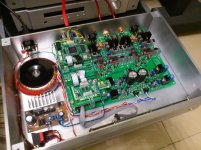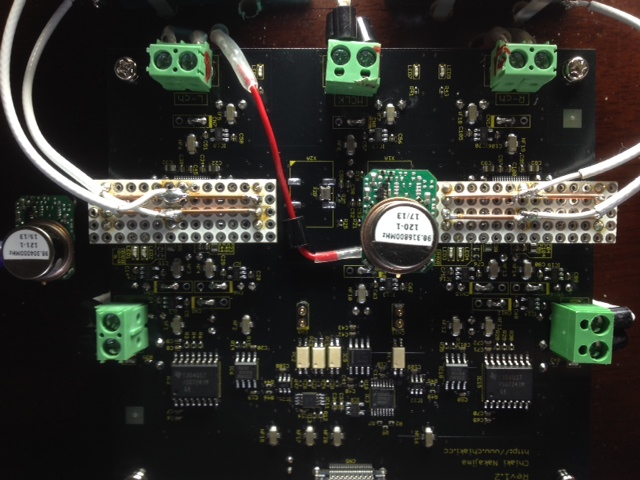Hi Greg,Ian (or anyone else),
Have you tried the Panasonic SP Polymer caps instead of the Tants there? Owen and Hochopeper both mentioned them, with Owen suggesting he preferred them to the Tants for his up-coming shunt reg board.
I'm building up the bare reg boards I got in one of the last GBs and am considering the Panasonics over the Tants
TIA!
Greg in Mississippi
I believe the key difference is ESR of the tantalum caps. The TPS7A4700 datasheet (page 12) recommends use of tantalum caps on input to damp any resonance between stray inductance of input wires/pcb traces and the low ESR ceramic / electrolitic capacitors. The reason given is that the control loop in the TPS7A4700 reg is wide bandwidth so resonance out at say 700kHz can impact on the regulator's performance. Reading between the lines it's possible that this is different in Owen's shunt regulator circuit however.
I don't have the gear to do wide bandwith psu testing but I'm building a few measurement pre-amps to measure say up to 100kHz or so. I'm building Frex's RMS + LNA measurement board some time in the next few months and Samuel Groener's measurement pre-amp from Linear Audio Vol 3 as well I don't expect that the difference of SP Cap vs Tant would necessarily show up within that bandwidth though.
As a slight tangent I thought I'd mention that I am part way through a design for a reg that I think will be reasonably well suited to the FIFO project.
It will have two isolated supplies both with rectifiers, LM317 pre-regulator followed by a TPS7A4700 with kelvin sense output all on the one PCB. Should suit powering each side of the FIFO in an isolated setup. Where as Ian's TPS7A4700 PCBs are well suited to local regulators these should give good performance without the bulk/heat of shunt regs.
Hopefully will have some pics to share in a few months since between Christmas and being snowed under at work things tend to move slowly for me at the moment. These will be the first boards that I test with the new measurement tools that I mentioned
Si570 clock board is designed to support digital audio stream from 44.1 KHz to 384 KHz, and xFs from 256*Fs to 2048*Fs. By taking the advantages of Si570, it could generate 8 audio frequencies, they are:
11.2896MHz, 12.2880MHz, 22.5792MHz, 24.5760MHz, 45.1584MHz, 49.1520 MHz, 90.3168 MHz, 98.3040MHz.
Among all of them, 90.3168 MHz and 98.3040MHz are optimized to ESS DACs.
Hi, FIFO users!
I'd like to ask your frank comments on a generic SQ difference, 90s MHz vs. 40s MHz synchronous master clocks for ES9018 DAC.
I'm sorry that I am not a user of Ian's FIFO. However, I guess a certain amount of FIFO users might have ever experienced the differences and have their own comments on the difference.
I recently compared NDK NZ2520 type oscillators of 40s MHz with those of 90s MHz on Chiaki's dual mono DAC tightly coupled with his SDTrans. My rough impression is;
- 40s MHz: more smooth and relaxed
- 90s MHz: sharp and of higher resolutions
I suppose some people may favor 40s MHz while others may favor 90s MHz. I'd like to know my impression is common or specific.
Thank you.
Ian - as Your product has given me so many hours of music pleasure I would like to officially wish you a Merry Christmas
//
x2
Merry Christmas Ian and to the whole community!



Ian - as Your product has given me so many hours of music pleasure I would like to officially wish you a Merry Christmas
//
+1 thanks Ian and thanks to all my diyA friends
Ian - as Your product has given me so many hours of music pleasure I would like to officially wish you a Merry Christmas
//
x2
Merry Christmas Ian and to the whole community!

+1 thanks Ian and thanks to all my diyA friends
Same from me to Ian and the "gang"!
Ed
Ian and the groupe, Merry Christmas in music






Thanks guys.
Enjoy you music and your project in the great 2014 !
Happy New Year !
Ian






Ian, really thanks for your FIFO! I enjoy music every day with my PCM 1794!
Good to know that. Enjoy your music!
BTW, you did very well finished DAC, looks very nice. Congratulations!
Ian
... I was tied up with GBV and couldn’t do any research job until last week I did some carefully comparison testing on this pair of OCXO with CCHD957 and Si570. ...
Fortunately I had a chance to test an ULNOCXO pairs with Chiaki's Dual Mono ES9018 DAC/SDTrans384. A comparison with prototype samples of NDK NZ2520SA 90s MHz oscillators was made.
I hope my report
http://www.diyaudio.com/forums/vendors-bazaar/240346-ultra-low-noise-low-power-consumption-ocxo.html#post3793511
would be interesting for some Ian's FIFO users and a production of the first batch of the high performance OCXOs will be realized by getting 100 preliminary orders from DIY users.
Hey guys,
i´ve got an email from A123 Systems with a link to their authorized on-line distributor in the US.
Look at the bottom of my blog entry!

I finally got A123 cell.
As si570 (MCLK out is fed to es9018) power supply, previously I have used salas sslv v1,1 - from AC mains , and alkaline batteries.
A123 cell is the best here.
Batteries give better soundstage and some comfort while salas shunt sounds more "polite".
And, A123 excels alkaline (1.5v*2 in series) especially in bass.
thank you!
Fortunately I had a chance to test an ULNOCXO pairs with Chiaki's Dual Mono ES9018 DAC/SDTrans384. A comparison with prototype samples of NDK NZ2520SA 90s MHz oscillators was made.
I hope my report
http://www.diyaudio.com/forums/vendors-bazaar/240346-ultra-low-noise-low-power-consumption-ocxo.html#post3793511
would be interesting for some Ian's FIFO users and a production of the first batch of the high performance OCXOs will be realized by getting 100 preliminary orders from DIY users.
Hello Bunpei
As a G.B ? have an idea of the price,are those that you specified.
But...
"The final price is heavily influenced by the production volumes, this survey is intended to understand if it exists enough interest for this OCXOs to start the production.
If the survey reveals enough interest the target price will be in the range 370.00 to 400.00 Euro per item + Shipment and VAT (21% now) if delivered in a EU country.
If you are interested in these OCXO this is the survey spreadsheet page: https://docs.google.com/spreadsheet/...UE&usp=sharing "
//
"The final price is heavily influenced by the production volumes, this survey is intended to understand if it exists enough interest for this OCXOs to start the production.
If the survey reveals enough interest the target price will be in the range 370.00 to 400.00 Euro per item + Shipment and VAT (21% now) if delivered in a EU country.
If you are interested in these OCXO this is the survey spreadsheet page: https://docs.google.com/spreadsheet/...UE&usp=sharing "
//
As a G.B ? have an idea of the price,are those that you specified.
clsidxxl,
as TNT posted you can find the information you need in the following thread: http://www.diyaudio.com/forums/vendors-bazaar/240346-ultra-low-noise-low-power-consumption-ocxo.html
There is a googledocs page where you can state your eventual interest: https://docs.google.com/spreadsheet/ccc?key=0AtPgpBGq_lTvdE5Na25jUk9yWTBTYTFfT1RWVzVfZUE&usp=sharing
We are working to improve the OCXO performance and to reduce the final price in the range 340/350 euro + Insured Shipment and VAT for buyer inside the EU.
The UNLOCXO Team
As for a DC +3.3V power supply I used a modified TI TPS7A4700 evaluation board(Ceramic capacitors on the board were replaced with multiple types of film capacitors based on my experiences). A big CDE 100 uF film capacitor is connected in the middle of the power line for decoupling though it does not appear in the photo. At the power input pin of the oscillator, I located/ does not locate/ an additional 47 uF Sanyo OS CON for a further decoupling.
I observed a maximum draw just after an initial power on was approximately 200 mA and it decreased gradually as time went and a stable draw after one minutes was approximately 50 mA.
As for the bead core applied to the power line, it is explained in my post on another thread of this forum.
http://www.diyaudio.com/forums/digital-source/142562-microsd-memory-card-transport-project-63.html#post3615018
It is not of a ferrite but a FINMET.
I observed a maximum draw just after an initial power on was approximately 200 mA and it decreased gradually as time went and a stable draw after one minutes was approximately 50 mA.
As for the bead core applied to the power line, it is explained in my post on another thread of this forum.
http://www.diyaudio.com/forums/digital-source/142562-microsd-memory-card-transport-project-63.html#post3615018
It is not of a ferrite but a FINMET.
Fortunately I had a chance to test an ULNOCXO pairs with Chiaki's Dual Mono ES9018 DAC/SDTrans384. A comparison with prototype samples of NDK NZ2520SA 90s MHz oscillators was made.
I hope my report
http://www.diyaudio.com/forums/vendors-bazaar/240346-ultra-low-noise-low-power-consumption-ocxo.html#post3793511
would be interesting for some Ian's FIFO users and a production of the first batch of the high performance OCXOs will be realized by getting 100 preliminary orders from DIY users.
Hi Bunpei,
Good to know your evaluated the OCXOs with impressed result. Your good news was my bad news
Regards,
Ian
I finally got A123 cell.
As si570 (MCLK out is fed to es9018) power supply, previously I have used salas sslv v1,1 - from AC mains , and alkaline batteries.
A123 cell is the best here.
Batteries give better soundstage and some comfort while salas shunt sounds more "polite".
And, A123 excels alkaline (1.5v*2 in series) especially in bass.
thank you!
Me too, same experience.
Cheers
Ian
- Home
- Source & Line
- Digital Line Level
- Asynchronous I2S FIFO project, an ultimate weapon to fight the jitter

